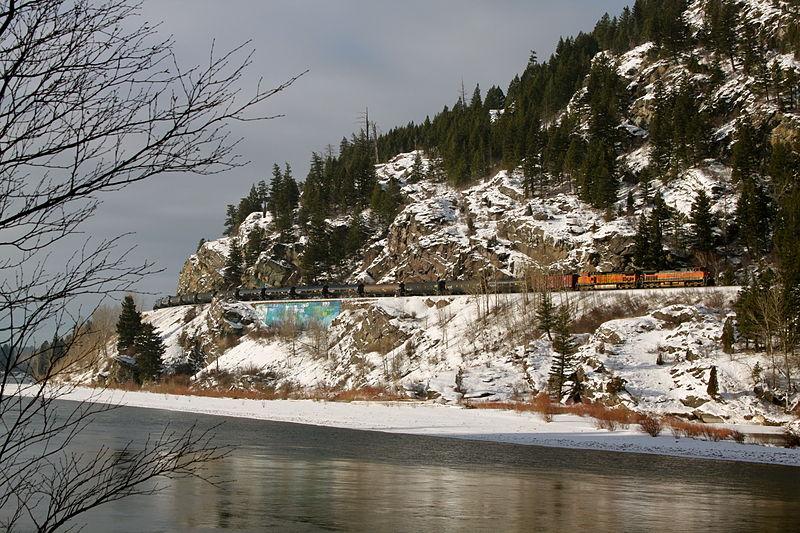Pipelines and oil trains provide different risks, rewards
An empty BNSF unit oil train passes through Bad Rock Canyon, Mont., after emptying its cargo of Bakken crude in January 2013. (Photo by Roy Luck via Wikimedia Commons.)
The recent spate of oil transportation accidents is fueling debate over how we should be moving fossil fuels.
A messy tar sands oil pipeline spill in March in Arkansas was followed by the July 6 derailment of an oil train in Canada, which incinerated the center of a small town in Quebec and left 50 people dead or presumed dead.
The train was bound for a refinery in New Brunswick, loaded with 72 cars full of crude oil from the fracking boom in North Dakota. These disasters raise questions about the relative safety of trains versus pipelines to transport oil. The use of trains to transport oil has skyrocketed in the U.S. — up 160 percent in the first quarter of this year, compared to last.
A large part of that rise is due to the development of the Bakken shale formation in North Dakota. In April of this year, North Dakota exported nearly 800,000 barrels of oil a day compared to just 80,000 barrels a day a decade ago.
Three quarters of the crude left North Dakota by train and as fracking technology continues to make the oil more available that amount is only expected to go up.
When it comes to the safety record of transporting oil — trains and pipelines are essentially the same, says Brigham McCown, the former head of the Pipeline and Hazardous Materials Safety Administration.
“When you look at total volume, pipelines do have a little bit of an edge in safety but, we’re splitting hairs in thousandths of a percent at that point,” McCown said.
Both trains and pipelines have a safety record of better than 99 percent. However, because pipelines transport 96 percent of oil in the US, they are responsible for many more spills each year. Just the day before the Canadian accident, for example, a pipeline in Montana spilled 25,000 gallons of gasoline on the Crow Indian Reservation.
The Association of American Railroads says in the last decade more than 470,000 barrels of oil were spilled by pipelines versus just over 2,200 spilled by trains.
McCown points out that pipelines also have an advantage over trains in terms of their greenhouse gas emissions.
“A pipeline is like a one way street; when you get to the end there’s no return trip required,” she said. “When you look at the carbon intensity of a locomotive, even though they are very efficient, you have to make that 1,200 to 1,500 mile trek, and then you have to turn the train around and bring the train back.”
Trains traditionally made that trek carrying coal but demand for coal is falling as natural gas becomes cheaper to extract. So the railroads are happy to have oil companies as a new customer.
But carrying oil by train is more expensive than loading it in a pipeline.
“For about a thousand mile journey a pipeline will add about $5 per barrel on to the cost and railroad would be $15,” McCown said.
So pipelines are slightly safer, cheaper and produce fewer carbon emissions – all arguments cited by supporters of the proposed Keystone XL pipeline to bring Canadian tar sands oil to Gulf Coast refineries.
The State Department report on Keystone calculated that the Alberta oil would be extracted even if Keystone isn’t built. The oil company TransCanada would just transport its oil by railroad.
But Kate Colarulli, director of the Sierra Club’s Beyond Oil campaign says that argument doesn’t hold water.
“The State Department’s analysis has been roundly criticized for being out of date and not based on current market information,” she said. “Just recently Goldman Sachs, they’re one of several different industry groups — financial industry and oil industry groups — that have come out and said that Keystone is actually a lynchpin for tar sands expansion. Rail is not a viable alternative for technological and economic reasons.”
And if rail transit is not a viable alternative to Keystone, critics argue that the pipeline project is essentially dead.
“Because the tar sands have been shown to have much greater climate consequences, it would be a mistake to continue to invest in expanding the tar sands,” Colarulli argued.
